Logans Run (film)
7 /10 1 Votes
3/4 Roger Ebert Duration Language English | 6.8/10 IMDb 68% Rotten Tomatoes Genre Action, Adventure, Sci-Fi Initial DVD release September 29, 1998 Country United States | |||||||||||||||||||||||||||||||||
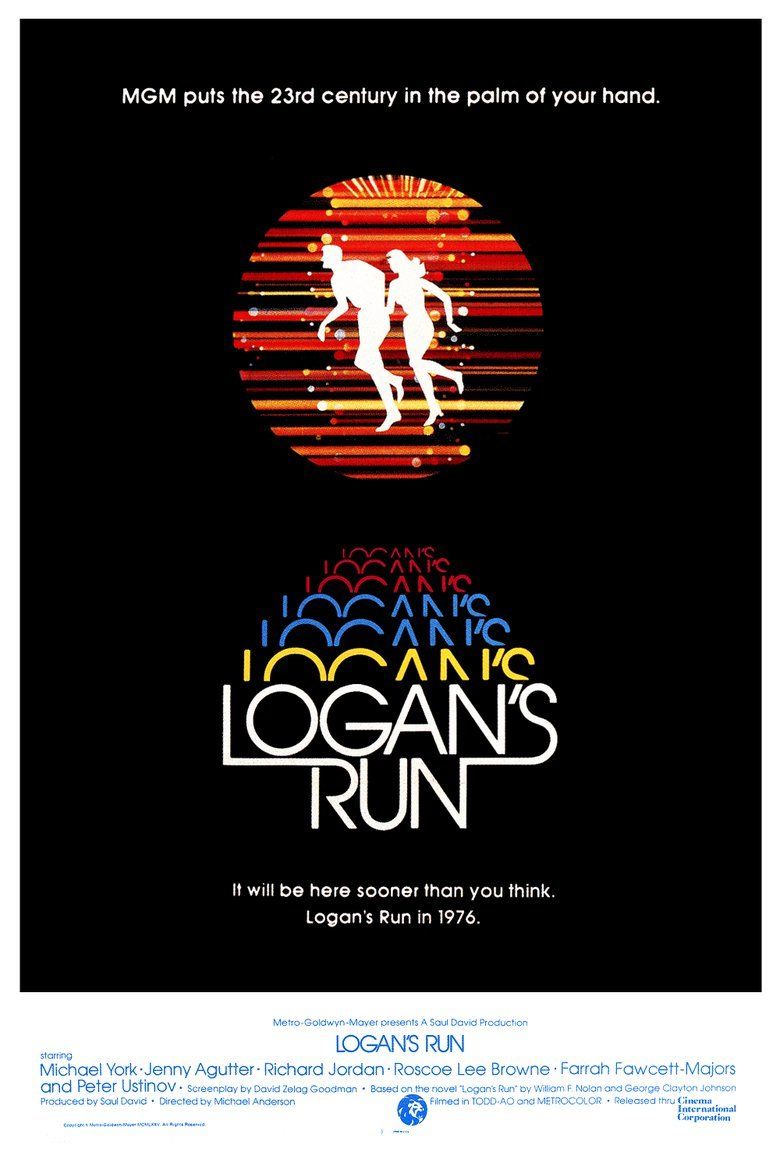 | ||||||||||||||||||||||||||||||||||
Release date June 23, 1976 (1976-06-23) Cast (Logan), (Francis), (Jessica), (Box), (Holly), (Old Man) Similar movies The Maze Runner , Knock Knock , Turkey Shoot , All Ladies Do It , Django Unchained , Halloween Tagline The only thing you can't have in Logan's world is your 30th birthday. Unless you run away. | ||||||||||||||||||||||||||||||||||
Logan s run official trailer 1 michael york movie 1976 hd
Logan's Run is a 1976 American science fiction film directed by Michael Anderson and starring Michael York, Jenny Agutter, Richard Jordan, Roscoe Lee Browne, Farrah Fawcett, and Peter Ustinov. The screenplay by David Zelag Goodman is based on the book Logan's Run by William F. Nolan and George Clayton Johnson. It depicts a utopian future society on the surface, revealed as a dystopia where the population and the consumption of resources are maintained in equilibrium by killing everyone who reaches the age of 30. The story follows the actions of Logan 5, a "Sandman", one who has terminated others who have attempted to escape death, and is now faced with termination, himself.
Contents
- Logan s run official trailer 1 michael york movie 1976 hd
- Plot
- Development
- Casting
- Filming
- Post production
- Themes
- Box office
- Critical response
- Accolades
- Legacy
- References
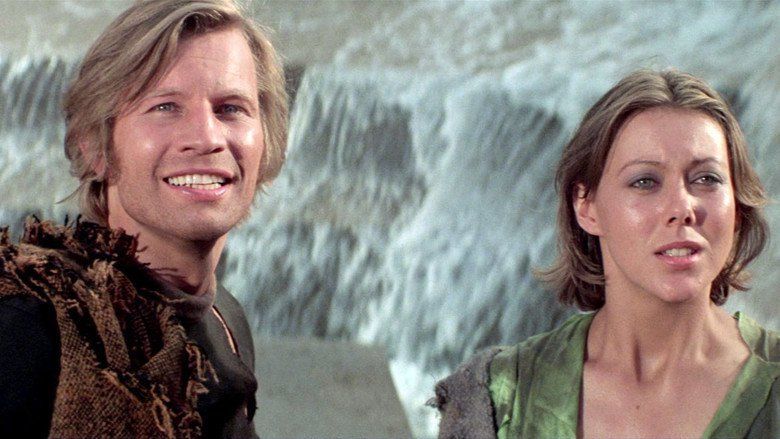
Produced by Metro–Goldwyn–Mayer, the film uses only the basic premise from the novel, that everyone must die at a set age and that Logan runs off with a female companion named Jessica, while being chased by fellow-Sandman, Francis. After aborted attempts to adapt the novel, story changes were made including raising the age of "last day" from 21 to 30 and introducing the idea of "Carrousel" [sic] for eliminating 30-year-olds. Its filming was marked by special-effects challenges in depicting Carrousel and innovative use of holograms and wide-angle lenses.

The film won a Special Academy Award for its visual effects, and six Saturn Awards, including Best Science Fiction Film. In 1977, a short-lived TV series aired, though only 14 episodes were produced. Since 1994, there have been several unsuccessful efforts to remake Logan's Run.
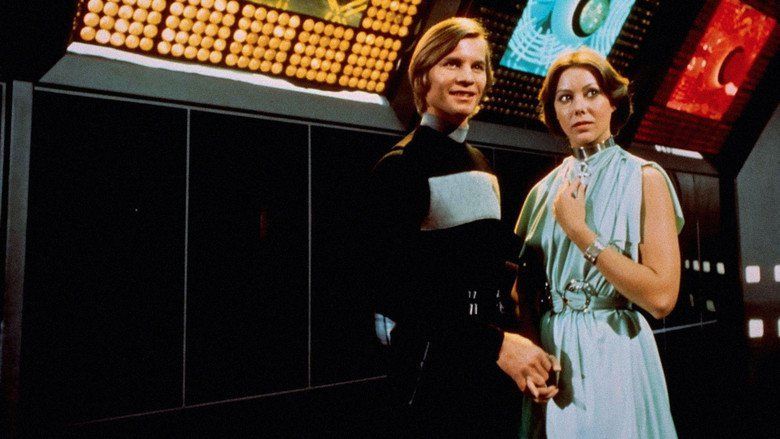
Plot

In the year 2274, the remnants of human civilization live in a sealed city contained beneath a cluster of geodesic domes, a utopia run by a computer that takes care of all aspects of their life, including reproduction. The citizens live a hedonistic life but, to maintain the city, everyone must undergo the ritual of "Carrousel" when they reach the age of 30. There, they are vaporized and ostensibly "renewed". To track this, each person is implanted at birth with a "life-clock" crystal in the palm of their hand that changes color as they get older and begins blinking as they approach their "Last Day". Most residents accept this promise of rebirth, but those who do not and attempt to flee the city are known as "Runners". An elite team of policemen known as "Sandmen", outfitted in predominantly black uniforms and serving in an agency of the city called "Deep Sleep", are assigned to pursue and terminate Runners as they try to escape.
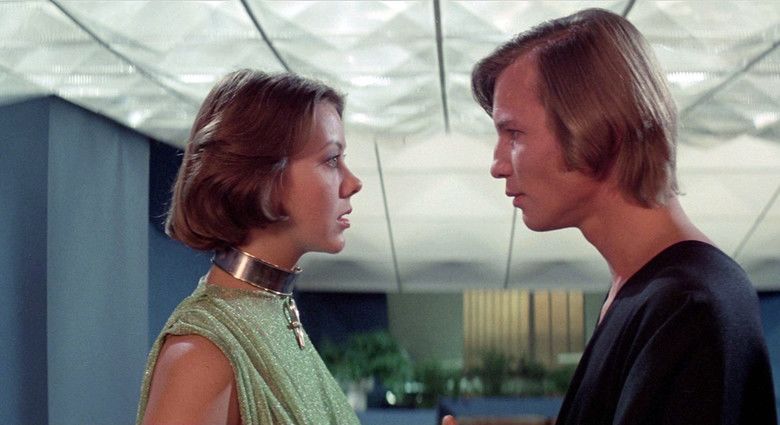
Logan 5 and Francis 7 are both Sandmen. After terminating a Runner, to whose presence they were alerted during a Carrousel ritual, Logan finds an ankh among his possessions. Later that evening, he meets Jessica 6, a young woman also wearing an ankh pendant. Logan takes the ankh to the computer, which tells him that it is a symbol for a secret group whose members help the Runners find "Sanctuary", a mythical place where they will be safe to live out the rest of their lives; it points out that the Sandmen have lost one thousand and fifty-six (1,056) Runners that way. The computer instructs Logan to find Sanctuary and destroy it, a mission he has to keep secret from the other Sandmen of Deep Sleep, which it code-names "Procedure 033-03". It then, by a procedure it calls "retrogram", changes the color of his life-clock to flashing red, making him suddenly four years closer to Carrousel. In order to escape Carrousel, Logan is now forced to become a Runner. Logan meets Jessica and explains his situation. They meet with the underground group that leads them to the periphery of the city. Logan finds that the ankh symbol is actually a key that unlocks an exit from the city. They come out into a frozen cave, with Francis following closely behind. In the cave, they meet Box, a robot designed to capture food for the city from the outside. Logan discovers to his horror that Box also captures escaped Runners and freezes them. Before Box can freeze Logan and Jessica, they escape, causing the cave to collapse on the robot.
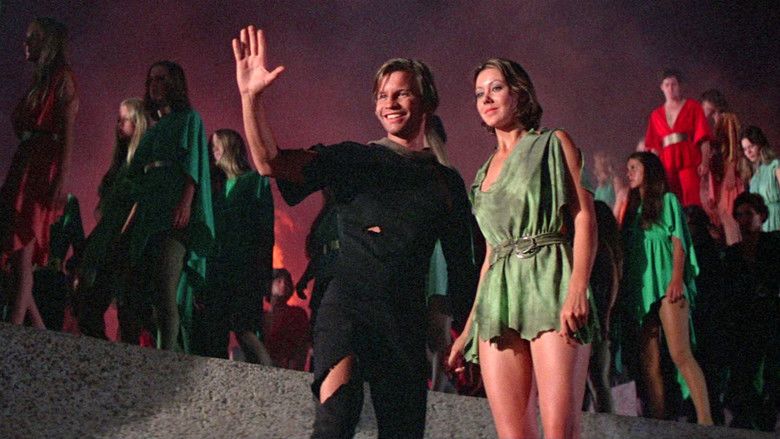
Once outside, Logan and Jessica notice that their life-clocks are no longer operational. They discover that the remains of human civilization have become a wilderness. They explore an old, seemingly abandoned city, which was once Washington, D.C. In the ruins of the United States Senate chamber, they discover an elderly man. His appearance is a shock to them, since neither has seen anyone over the age of 30. The old man explains what he remembers of what happened to humanity outside the city, and Logan realizes that Sanctuary is a myth and had been all along. However, Francis has followed them and he and Logan fight. Logan fatally wounds Francis and as he dies, he sees that Logan's life-clock is now clear and assumes that Logan has renewed. Logan and Jessica persuade the old man to return to the city with them as proof that life exists outside the domed city. Leaving the man outside, the two enter and try to convince everyone that Carrousel is a lie and unnecessary. The two are captured by other Sandmen and taken to the computer. The computer interrogates Logan about Assignment 033-03 and asks if he completed his mission, but Logan insists, "There is no Sanctuary." What he had found was "old ruins, exposed", "an old man", and that the missing Runners were "all frozen". These answers are not accepted by the computer, even after scanning Logan's mind, and the computer overloads, causing the city's systems to fail violently and release the exterior seals. Logan, Jessica, and the other citizens flee the ruined city. Once outside, the citizens see the old man, the first human they have met who is older than 30, proving that they can, indeed, live their lives much longer.
Development

MGM's early attempts to adapt the book led to development hell. Producer George Pal's attempt was troubled in 1969 by competing views of what the film's story should be, including the possibility of incorporating symbolism of real life issues, in comparison to screenwriter Richard Maibaum's vision. Rewriting Maibaum's screenplay would have taken between two and three months, and the budget would have had to have been reassessed. Pal became concerned the delays would cause the film to miss the wave of success science fiction was enjoying with 2001: A Space Odyssey and Planet of the Apes in 1968.
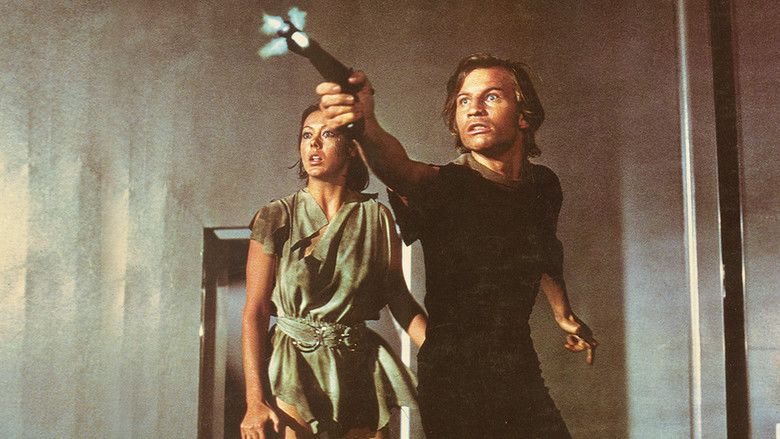
American International Pictures offered to buy Pal's projects, including Logan's Run, for $200,000, but MGM declined, only willing to accept a minimum of $350,000. Pal left the project to produce Doc Savage: The Man of Bronze (1975) for Warner Bros. Saul David assumed responsibility in 1974, with Soylent Green author Stanley R. Greenberg assigned to write. Greenberg devised the idea of Carrousel but afterwards dropped off the project. David Zelag Goodman wrote a nearly completely new screenplay, raising the age of death from 21 to 30 to allow for more actors to be considered for casting.
Casting
York, Agutter, and William Devane were cast in the lead roles, with Devane announced to play an "elite" Sandman in May 1975. Devane withdrew from the project and replaced Roy Thinnes in Alfred Hitchcock's 1976 film Family Plot.
Richard Jordan stepped in for Devane and was best known for his performances in Lawman (1971), Chato's Land (1972), Rooster Cogburn (1975) and the 1976 TV mini-series Captains and the Kings. York had previously appeared in Cabaret (1972), The Three Musketeers (1973) and Murder on the Orient Express (1974), while Agutter was best known for The Railway Children (1970) and Walkabout (1971). York and Agutter were 33 and 23 respectively, casting made justifiable by Goodman raising the age of death to 30.
In September 1975, it was announced Peter Ustinov would play "the last man alive in Washington, D.C." in the film. Farrah Fawcett has a small role, but her rising celebrity in television earned her prominent credit as Farrah Fawcett-Majors.
Filming
Special effects artists L. B. Abbott and Glen Robinson regarded Carrousel as the most difficult part of the film to portray, requiring hidden wires to depict the levitation. For the scene where Logan is interrogated by the Deep Sleep central computer, it was decided genuine holograms would be most convincing, with Saul David advocating a new hologram effect be created. The robot character Box was portrayed by placing actor Roscoe Lee Browne in a robot costume.
The filmmakers also made use of wide-angle lenses not generally available. It became the first film to use Dolby Stereo on 70 mm prints. Nine entire sound stages were used at MGM in Culver City, California, hosting a miniature city among the largest of its kind built to date. Producers saved $3 million by finding readily available locations in numerous Dallas buildings, the Fort Worth Water Gardens, and the Hyatt Regency Hotel in Houston. The Sewage Disposal Plant in El Segundo, California was used for the underground escape sequences.
Post-production
Post-production took eight months, including completion of the score. The score was composed and conducted by Jerry Goldsmith, with orchestrations by Arthur Morton. The score "adheres to two distinct sound palettes: strings, keyboards and abstract electronics only for cues inside the City and full orchestra for outside." The first release of portions of the score was on MGM Records on LP, in 1976. The complete expanded and newly remixed score was issued on CD in January, 2002 by Film Score Monthly.
The film was previewed for test audiences prior to its release. A few sequences were edited or shortened as a result. These included a longer sequence in the ice cave, where Box asked Logan and Jessica to pose for his ice sculpture. This was cut due to extensive nudity so that the film could receive a PG rating and for length. Other scenes were removed, including a sequence where Francis hunts down a runner by himself at the beginning of the film. Other sequences were trimmed. Some of these scenes are featured as extras in the 1998 DVD release. Other scenes survive in the shooting script, but the footage appears lost. At the end of the process, the budget had escalated from the projected $3 million to $9 million, an expensive film for 1976. It was noted for being the most expensive MGM film made in 10 years, with most of the budget going to the sets.
Themes
Logan's Run explores utopian and dystopian themes, with the idea that characters willingly die instead of reaching advanced ages, reflecting the idea that "Utopias require its participants to give something up in order to create harmony and uniformity". Common dystopian themes include an evil ruling authority, the confiscation of children from parents, life in a city, and the idea of human overpopulation, in this case causing the protagonists to leave the urban environment.
Prominent concepts in the film are "the dangers of hedonism, youth worship, and, particularly, the dangers of government-sponsored euthanasia". The hedonism is primarily conveyed in the form of sensuality and "images of sexual abandon". Aside from sexual freedom, the pursuit of pleasure is also reflected in how this was envisioned in the 1970s, including miniskirts, little career, relaxed gyms, and Farrah Fawcett's "shag" haircut. Author Barna William Donovan argues this serves to criticize many social developments underway in the 1970s, targeting the "Me generation". Writer Robert Tinnell hypothesizes the design of the city, reminiscent of a shopping mall, is also suggestive of "anticonsumerist sentiment". The film may ultimately serve as a warning against overthrowing older generations, aimed at young viewers following the counterculture movements in the 1960s. Another interpretation is that individualism, the "freedom to live and be," is curbed by "social mechanisms" telling citizens to have a good life for only a limited time. Logan, originally part of an "artificial society" centred on "pleasure and spectacle," becomes "re-individualised" and defies a "conformist system". Despite the reflections of the 1970s, Donovan argues the film may also have relevance to the Internet age, with elements evocative of online dating.
Writers have also examined the film's statements on gender and race. Logan casually asking Jessica whether she is a lesbian when she is initially uninterested in him indicates homosexuality is no longer taboo, a possible side effect of sex no longer being related to child bearing. Ultimately, author Bonnie Noonan believes the idea of returning to the concept of "beloved wife" is a sign that in the story, women's liberation, and not technology, is at the root of the dystopia. The character of Box, being voiced by black American actor Roscoe Lee Browne, could serve as a precursor to Darth Vader, voiced by black American actor James Earl Jones in Star Wars (1977), in "racializing cyberphobic primers available to Generation X".
Box office
In its first five days in theatres in 1976, Logan's Run grossed $2.5 million, a substantial sum. The film finished its run with a gross of $25 million in North America, and a solid performance in other territories.
The film is credited with helping MGM recover from debt, and was a hit with young audiences in particular.
Critical response
The film received a generally mixed response. Roger Ebert gave the film a three-star rating, calling the film a "vast, silly extravaganza", with a plot that's a "cross between Arthur C. Clarke's The City and the Stars and elements of Planet of the Apes" and "that delivers a certain amount of fun". Variety staff called the film "rewarding" in its escapism and intelligence.
The New York Times was less positive:
Just why and for what particular purpose Logan makes his run is anything but clear after you've sat through nearly two hours of this stuff. Logan's Run is less interested in logic than in gadgets and spectacle, but these are sometimes jazzily effective and even poetic. Had more attention been paid to the screenplay, the movie might have been a stunner.
New York was also negative, writing the film was "yet another of those tiresome world-after-the-holocaust bits," and "hardly a hop for your money". However, the review complimented York and Agutter as "gifted".
In 2000, Ian Nathan wrote in Empire that the film "can’t escape its '70s origins", but contains "warnings about decadence, ageism, and allowing technology and science to run riot, done to a disco groove". In his 2015 Movie Guide, Leonard Maltin gave the film two stars, finding the first half "dazzling" and the second "dreary". In 2015, Rolling Stone named it 27th among the 50 Best Sci-Fi Movies of the 1970s. The film has a 68% approval rating on Rotten Tomatoes, based on 28 reviews.
Accolades
At the Academy Awards, the film won a Special Academy Award for visual effects, tied with the 1976 remake of King Kong, indicating Logan's Run made its mark in visual and special effects that few previous science fiction films had the money for. Logan's Run was very popular at the Saturn Awards, winning the six awards, including Best Science Fiction Film. The film was also in competition for the Golden Prize at the 10th Moscow International Film Festival.
Legacy
Intrigued by the film's success with young viewers, CBS and MGM Television paid Nolan $9 million to base a television series on the film, but after debuting in 1977, the series was cancelled before the end of the season. MGM also expressed interest in adapting Nolan's sequel novel Logan's World, but Saul David had opted to focus on the television series instead. In 2000, ideas for a film remake centred on a more faithful adaptation of the novel, restoring Crazy Horse Mountain and the sky gypsies.
Marvel Comics published a short-lived comic book series in 1977, with George Pérez drawing five issues between January and May 1977, with "acceptable" sales. The comics adapted the film's story in five issues and briefly continued beyond. In his art, Pérez sought to follow the art direction of the film. The book was cancelled after issue #7 in July 1977.
References
Logan's Run (film) WikipediaLogans Run (1976 film) IMDbLogans Run (1976 film) Roger EbertLogans Run (1976 film) Rotten TomatoesLogans Run (film) themoviedb.org
